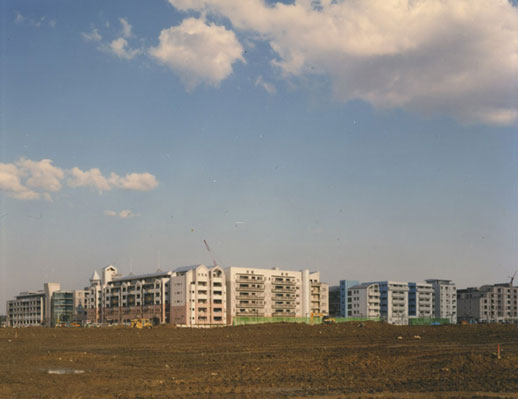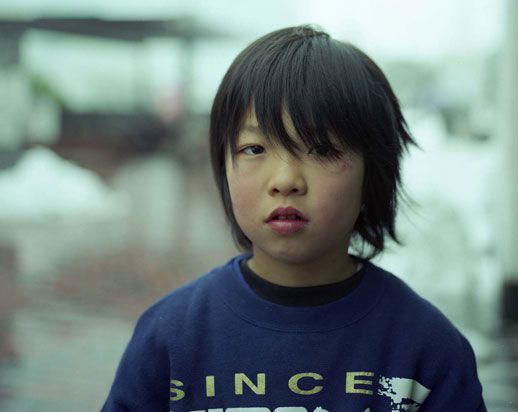A Fog of Ennui
In 1998, Takashi Homma’s exhibition “Tokyo Suburbia” was held at Parco Gallery in Shibuya, and an award-winning photo book of the same name was subsequently published. The photos currently showing at Gallery 360° are from this same quietly unsettling series of suburban Tokyo and its strange inhabitants, focusing in particular on suburban residential areas and its kids.

One particular photograph of a circular, Sci-Fi-esque building with a large sign “Hotel UFO” hovering above it sets the tone of the exhibition. Homma presents suburban Tokyo as an alien town — strangely familiar but somehow not quite right. Identical rows of “Western-style” modern Japanese houses line artificial paths, their fences mimicking American suburban residences. The people who populate these scenes are young, but their faces remain expressionless. Tinged in milky blue and orange, these images look as though they have been shot at twilight, enhancing the hazy opaqueness that feels impenetrable. It is as if the (Hotel) UFO landed in suburban Japan and shrouded it in a fog of ennui and numbing complacency, rendering the inhabitants blank and even a little alien-looking themselves.
There is one full-length shot of a girl in school uniform that I am particularly referring to here with a crouching posture and spoon-shaped eyes, but the other subjects — a hip high-school student wearing sneakers and his baggy pants low, young pale children staring into the camera or immersed in an arcade video game — also show the same dazed expression tinged with a hint of frailty, as if floating in a sterile world of hastily-built concrete box buildings and artificiality, waiting for it to all crumble at any moment.

Is Homma suggesting that this alien sense of existence is somehow the product of the ominous blanket of Westernization? One image shows a young man with dyed blond hair sitting at a McDonald’s, his face covered by the company logo on the window. Another gazes down on crumpled burger wrappers in a parking lot, again revealing the unmistakable golden arches. The atmosphere that Homma is portraying here is that of many suburban towns near Tokyo — a placeless and nameless modern space that lacks any sign of the old, “traditional” Japanese features like tiled roofs or the iconic red square backpacks (randoseru) worn by elementary schoolchildren. And yet, despite the sense of modernization having swept through the town as though overnight, and the subsequent seeming loss of roots details like this the empty wrapper or the deserted residential streets imbue these scenes with a certain calm, even if it is desolate.
While it is all too easy to point an accusing finger at such social phenomena, it seems as if Homma has deliberately tried to emphasize these aspects in conveying the general unease of his portrayed suburbia. Although these pictures were taken over the fifteen years from 1993 to 2007, the images are timeless and still a very relevant meditation on a side of Tokyo that has become so “normal” that its strangeness if often overlooked. In revisiting this series for this exhibition, Homma’s portrayal of Tokyo’s suburbia invites the viewer to ponder yet another hidden space in Tokyo’s vast expanses that is worthy of further consideration.
Lena Oishi
Lena Oishi



